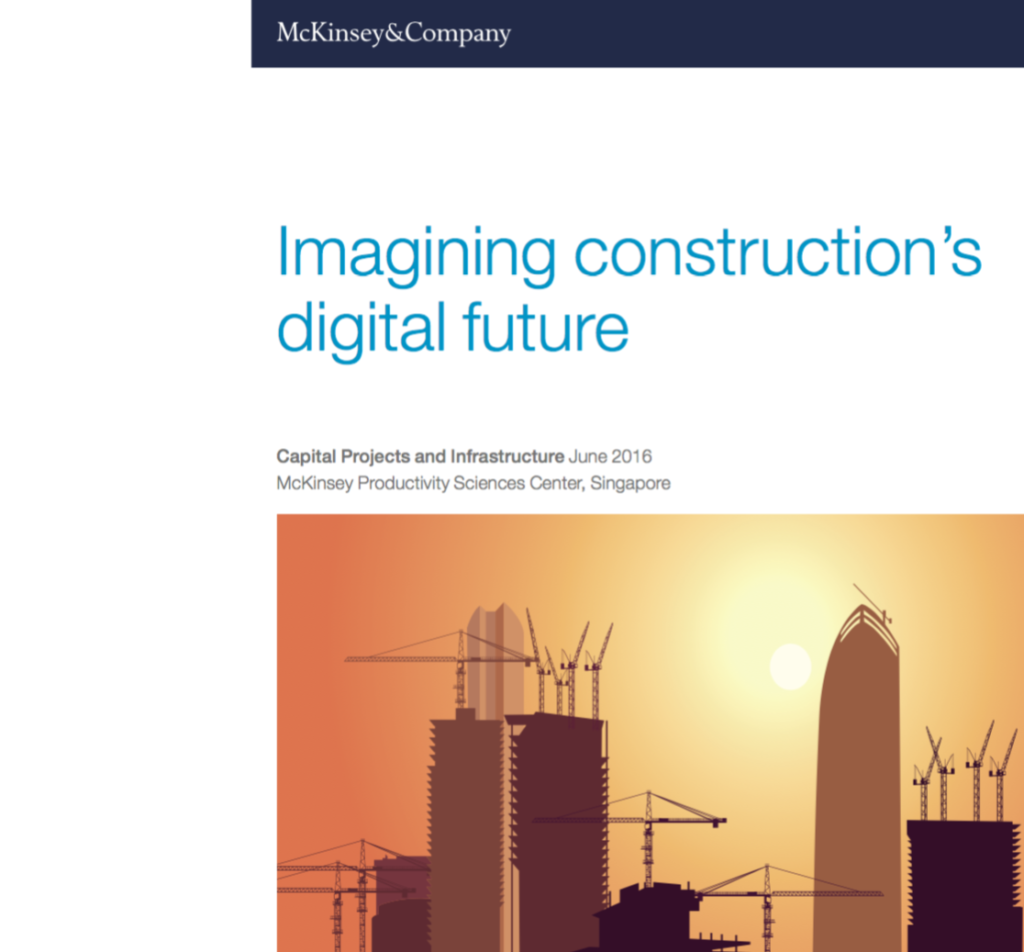(Extract from McKinsey June 2016 Report: ‘Imagining Construction’s Digital Future’)
Doka would like to thank McKinsey & Partners for their insight, clarity of expression in this invaluable paper on the required on the challenges and required changes facing the future of Construction. To download this full paper either visit www.mckinsey.com or alternatively www.doka.uk.com
UK, december 9, 2016.- Some sobering facts about Construction Industry performance:
- Large construction projects typically take 20% longer to finish see exhibit 1
- 80% overrun their budget
- Construction productivity has been in long term decline see exhibit 2
- Financial returns for Contractors are often low and volatile.
- R&D spending is <1.0% of revenue
- Spending on IT is <1.0% revenue see exhibit 3
The Construction sector has been slow to adopt processes and technology innovations, along with the continuing challenges when it comes to fixing the basics;
- Project planning remains uncoordinated between office and site
- Contracts do not include incentives to share risk
- Performance management is often inadequate
- Supply-chain practises are still unsophisticated
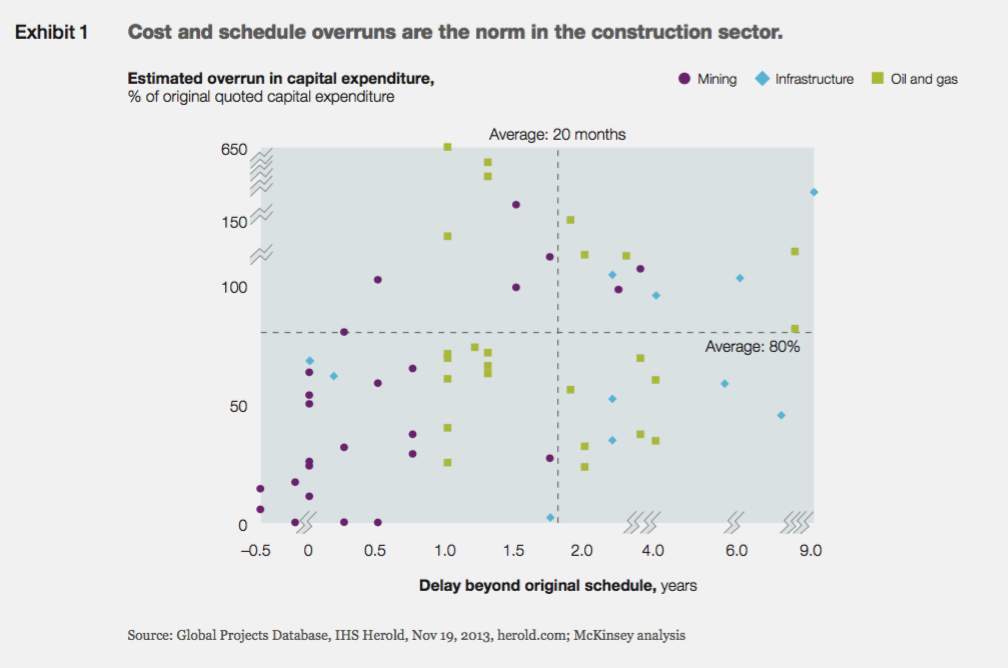

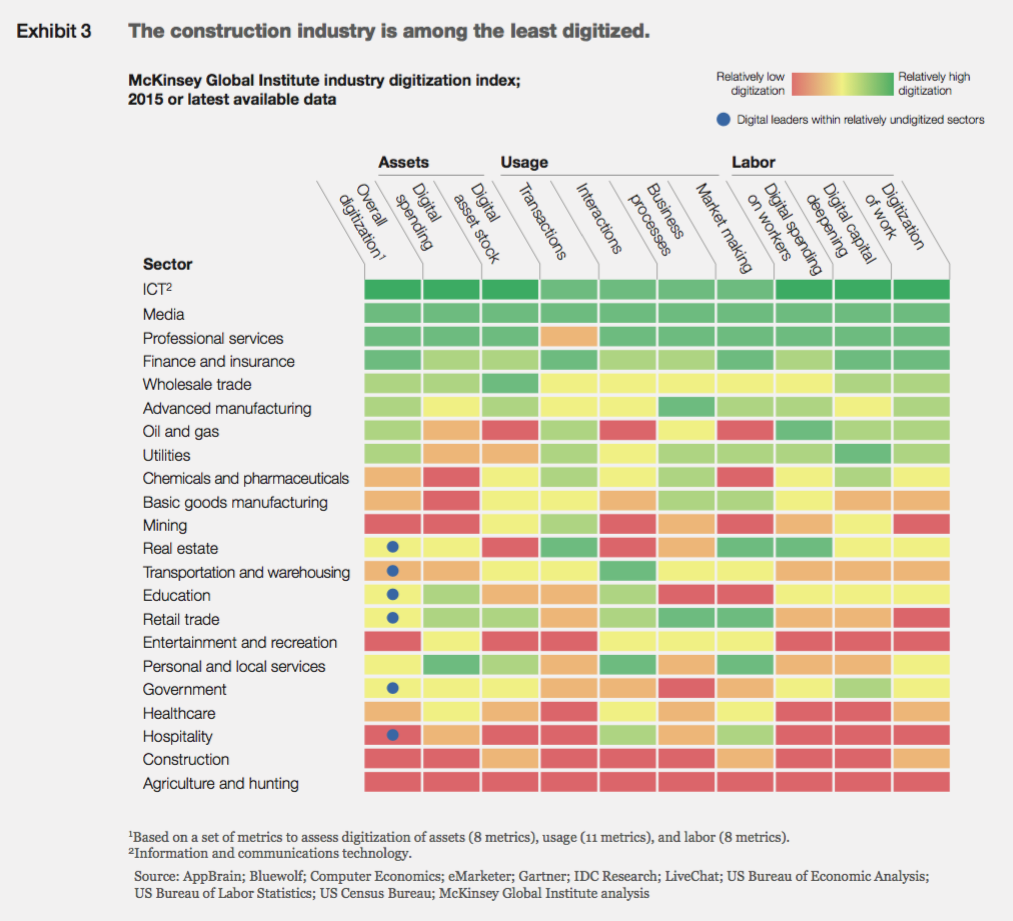
However, we know that none of this is going to get easier.
- Projects are more complex and larger in scale.
- Greater demands made for environmentally sensitive construction
- Shortage of skilled labour and supervisory staff
- Traditionally the sector has executed incremental improvement of the back of the belief that each project is unique
- The sector believes it is impractical and not possible to scale up new ideas and embracing technology
McKinsey estimate that the world will need to spend €57 trillion on infrastructure by 2030 to keep up with global GDP growth. This is a massive incentive for players in the construction industry to identify solutions to transform productivity and project delivery through new technologies and improved practicas. McKinsey have identified 5 big ideas that help make the desired changes, none are blue sky and all are plausible, they are:
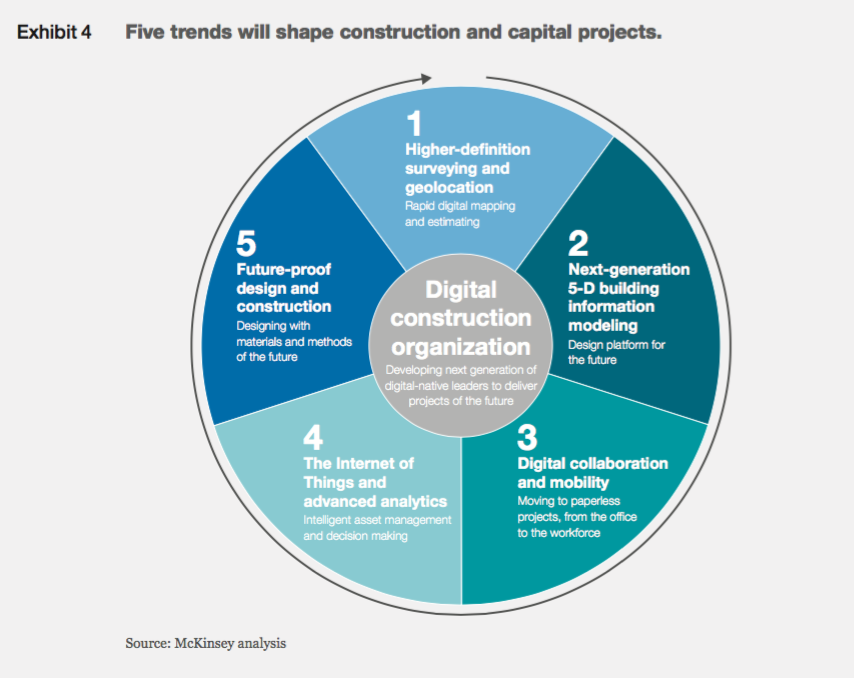
1. Higher-definition Surveying & Geoloaction; geological surprises are a major reason projects are delayed and go over budget. Discrepancies between ground conditions and early survey estimates can require costly last-minute changes to project scope and design. New techniques that integrate high-definition photography, 3-D laser scanning, and geographic information systems, enabled by recent improvements in drone and unmanned-aerial-vehicle (UAV) technology, can dramatically improve accuracy and speed.
2. Next –generation 5D Building Information Modelling; Next-generation 5-D BIM is a five-dimensional representation of the physical and functional characteristics of any project. It considers a project’s cost and schedule in addition to the standard spatial design parameters in 3-D. It also includes such details such as geometry, specifications, aesthetics, thermal, and acoustic properties. A 5-D BIM platform allows owners and contractors to identify, analyze, and record the impact of changes on project costs and scheduling (Exhibit 6). The visual and intuitive nature of 5-D BIM gives contractors a better chance to identify risks earlier and thus to make better decisions. For example, project planners can visualize and estimate the impact of a proposed change in design on project costs and schedule.

3.Digital collaboration and mobility; Process digitization means moving away from paper and toward online, real-time sharing of information to ensure transparente and collaboration, timely progress and risk assessment, quality control, and, eventually, better and more reliable outcomes. One reason for the industry’s poor productivity record is that it still relies mainly on paper to manage its processes and deliverables such as blueprints, design drawings, procurement and supply-chain orders, equipment logs, daily progress reports, and punch lists. Due to the lack of digitization, information sharing is delayed and may not be universal. Owners and contractors therefore often work from different versions of reality. The use of paper makes it difficult to capture and analyze data; that matters because in procurement and contracting, historical performance analytics can lead to better outcomes and risk management. Mismanaged paper trails also routinely spur disagreements between owners and contractors on such matters as construction progress, change orders, and claims management. Finally, paper trails simply take more time.
The availability of low-cost mobile connectivity, including via tablets and handheld devices, has ushered in a new generation of “mobile first” cloudbased crew-mobility apps that can be deployed, even on remote construction sites, with real-time updates. These are commercially viable for contractors and project owners of all sizes.
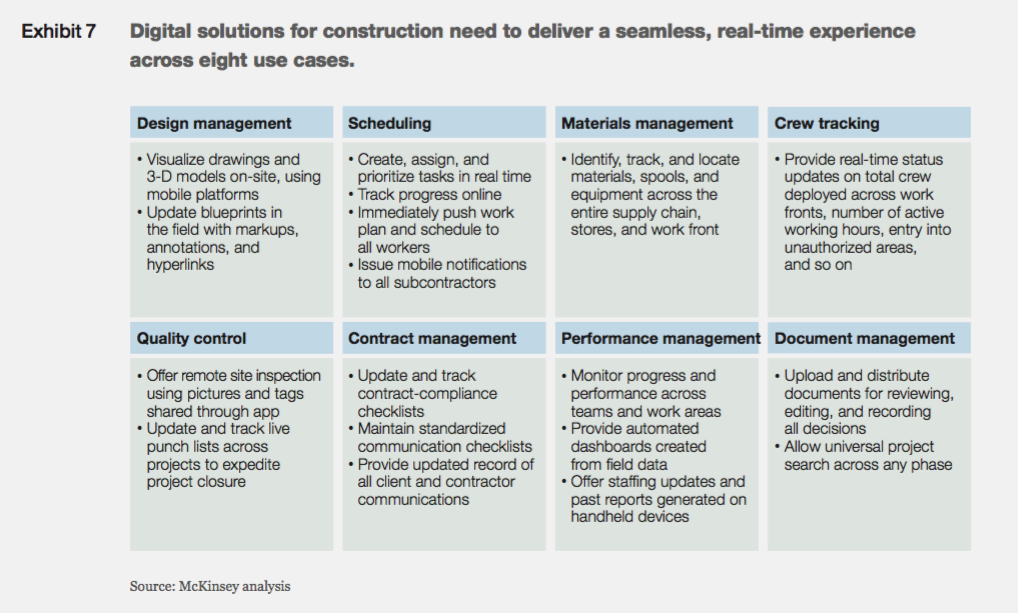 4. The Internet of Things and advanced analytics; By measures such as the number of people, the profusion of construction equipment, and the amount of work going on at the same time, project sites are getting denser. They now generate vast amounts of data, a majority of which is not even captured, let alone measured and processed. The Internet of Things is a reality in many other sectors; sensors and wireless technologies enable equipment and assets to become “intelligent” by connecting them with one another. On a construction site, the Internet of Things would allow construction machinery, equipment, materials, structures, and even formwork to “talk” to a central data platform to capture critical performance parameters. Sensors, nearfield-communication (NFC) devices, and other technologies can help monitor productivity and reliability of both staff and assets. There are several potential uses:
4. The Internet of Things and advanced analytics; By measures such as the number of people, the profusion of construction equipment, and the amount of work going on at the same time, project sites are getting denser. They now generate vast amounts of data, a majority of which is not even captured, let alone measured and processed. The Internet of Things is a reality in many other sectors; sensors and wireless technologies enable equipment and assets to become “intelligent” by connecting them with one another. On a construction site, the Internet of Things would allow construction machinery, equipment, materials, structures, and even formwork to “talk” to a central data platform to capture critical performance parameters. Sensors, nearfield-communication (NFC) devices, and other technologies can help monitor productivity and reliability of both staff and assets. There are several potential uses:
- Equipment Monitoring & Repair
- Inventory Management & Ordering
- Quality Assessment
- Energy Efficiency
- Safety
5. Future-proof design and construction; New building materials, such as self-healing concrete, aerogels, and nanomaterials, as well as innovative construction approaches, such as 3-D printing and preassembled modules, can lower costs and speed up construction while improving quality and safety. Building materials represent a $1 trillón global industry; materials usually account for more than half the total cost of projects. Traditional materials such as concrete, cement, and asphalt make up most of this demand. But new and better construction materials are also required due to several trends:
- Green Construction
- Cost efficiency
- Supply-chain agility
- Improved durability and strength
- Off-site construction
McKinsey make 4 key recommendations for action: Given the construction industry’s poor track record on innovation and the adoption of new technologies, tools, and approaches, project owners and contractors need to adopt a new mindset. Owners often believe that their responsibility ends when they award contracts, forgetting that they pay the economic costs of delay. For their part, contractors often do only the minimum required to meet contractual terms, leaving substantial value on the table. For the industry to do better, it needs to embrace four principles.
- Transparency & risk sharing contracts
- Return-on-investment orientation
- Simplicity and intuitiveness in the design
- Change management
In conclusion: Other industries have shown that first movers can build a sustainable competitive advantage. In the construction sector, this is also likely to be the case. Over the next decade, these winners of tomorrow will take the lead in technology innovation and digitization. Resisting change is no longer an option.
